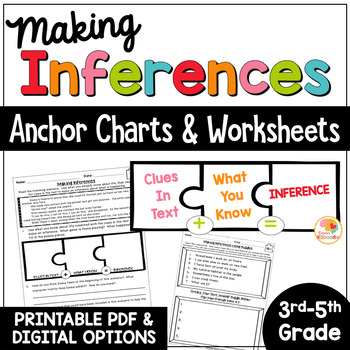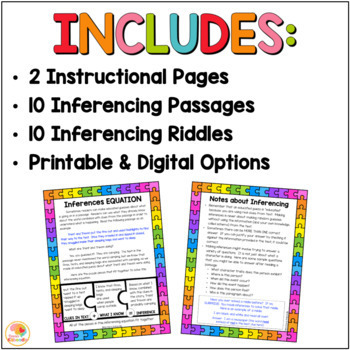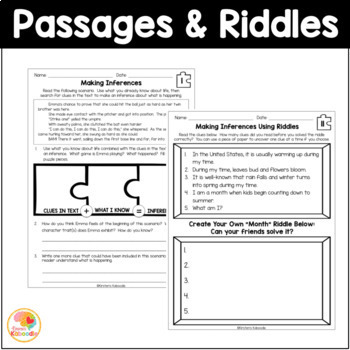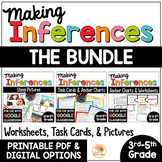Making Inferences Anchor Chart Reading Passage Activities Worksheets 3rd 4th 5th
- PDF
- Google Apps™

What educators are saying
Also included in
- Making Inferences with Pictures, Passages, Task Cards, and Anchor Charts BUNDLE:These inferencing worksheets, passages, and task cards are perfect for your 3rd-5th grade students because they provide visual supports as well as a variety of approaches for showing kids how inferencing actually works.PPrice $12.50Original Price $16.50Save $4.00
Description
The perfect inference worksheets for your 3rd, 4th, or 5th grade classroom. Inferencing is a hard skill to teach but these inferencing activities will help your students practice making inferences with reading passages. I have taught making inferences in 3rd grade and I can truly say that these worksheets were a wonderful addition to my lessons.
These making inferences worksheets for 3rd, 4th, and 5th grade give students practice searching for clues to make inferences as well as creating riddles to be "on the other end" of inferencing. What an EASY way to make inferencing FUN for your students with these short stories!
This inferencing product contains:
- 2 instructional pages with examples and explanations (anchor charts) of making inferences
- 10 inferencing passages and related questions designed to show students how inferencing works (these pages also incorporate the inferencing equation with the puzzle pieces)
- 10 pages of riddles where students use inferencing skills to solve the riddle as well as space on each page to create their own riddle (using the same category as the riddle that they solved)
Allowing students to use a variety of inferencing activities increases their understanding of inferencing. For example, creating riddles helps students use inferencing skills at a deeper level.
NOTE: You will find the digital link and instructions on the final 7 pages of the product.
NOTE: THIS FILE NOW INCLUDES A DIGITAL DISTANCE LEARNING OPTION!
As of 3/24/20, this product includes a digital option (as well as the no prep printable option). The instructions for utilizing the digital portion appear at the end of the packet.
Technology Requirements:
- A Google Drive account
- If sharing with students, a Drive account that is linked to student Google accounts
- Can be shared/delivered on Google Classroom
- Only need access to Google Drive--no outside links to worry about!
This file can be used with iPads, chrome books, laptops, and desktops as long as your students have access to Google Drive or Classroom on a device. The digital portion of this product is on Google Slides™.
Please click on the preview to see a sample of the layout and send me a message if you have any questions!
Please note that there are TWO additional inferencing products available in my store here (you can also purchase all three products in a bundle at a discount). Here are the links:
MAKING INFERENCES PRINTABLES AND RIDDLES
MAKING INFERENCES USING PICTURES
You may also be interested in these task card and/or grammar products:
Kirsten Tulsian has 18 years of experience in elementary education. She has been a homeroom teacher for first grade, third grade, and fourth grade, as well as ESL. She has also been a school counselor for grades PK-6, an ESL pullout teacher for K-6, and a Reading Recovery Teacher. She received her Bachelor’s degree in elementary education and psychology from The University of Iowa and a Master’s of Education in school counseling from Sam Houston State University. She believes that students make the most progress when they are engaged in their hearts as well as their minds. Her resources offer relevant, rigorous, engaging content that nurtures the whole child.
IMPORTANT NOTICE:
Copyright © Kirsten’s Kaboodle. All Rights Reserved.
• Purchasing this product gives the purchaser ONE LICENSE to this product. This allows the purchaser the right to reproduce this product for HIS/HER class ONLY.
• Duplication for an entire team, school, or school district is strictly forbidden.
• If other teachers would like copies of this product, please direct them to my store.
• You may not reproduce, redistribute, or post this item on a blog or website for download (free or paid).
• Copying any part of this product (even for a classroom website) is also in violation of the Digital Millennium Copyright Act.
• You may not modify, copy, or alter this product in any way.
• Please feel free to spread the word about this product via social media or blog post. A link to the product (or my store) is much appreciated.






